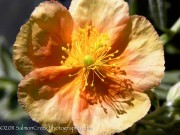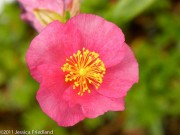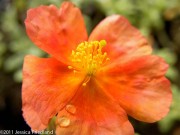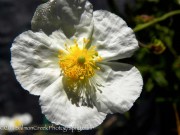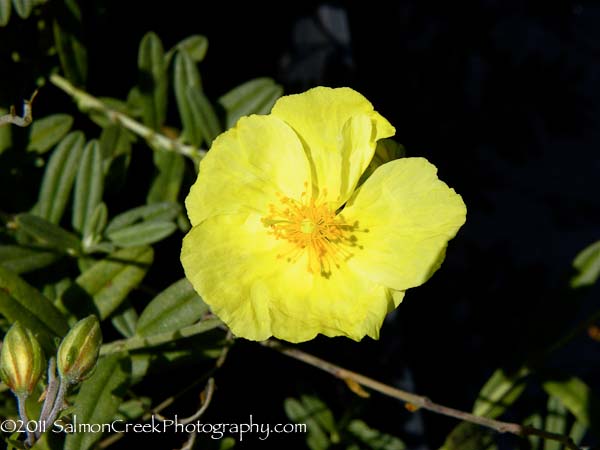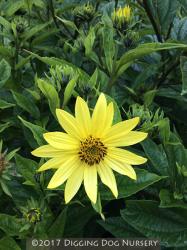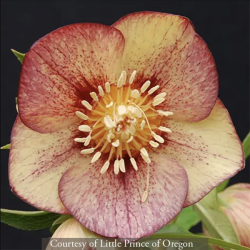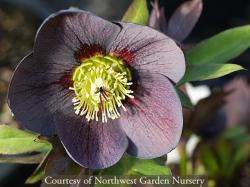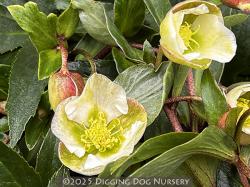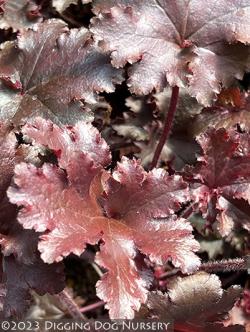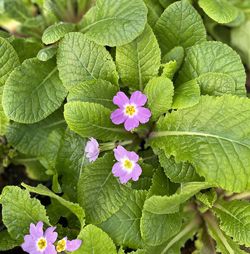Includes Helenium, Helianthemum, Helleborus, & Heuchera
Haloragis erecta ‘Wellington Bronze’ (P-0614)
Each $10.75
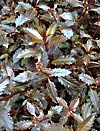
Inconspicuous in bloom, but indispensable for foliar variety, this New Zealand native is named after Mum’s hometown on the North Island. The dense mound of small, linear, bronze leaves on wine-colored stems is useful wherever contrast of form and foliage is valued.
In our mixed border, we combine ‘Wellington Bronze’ with Lavandula ‘Ana Luisa’, Euphorbia ‘Black Pearls’ and Stipa arundinacea for an engaging array of texture and color. Cut off the small flowers to prevent seeding.
Blooms September.
Size: 3' 0" high x 3' 0" wide.
Hardy to zone 6.
Helenium
Helensflower
Legend has it that Helenium first grew on ground watered with the tears of Helen of Troy. The backbone of the late season garden, they send out branching stems covered with red, yellow, orange and bronze daisy-like flowers that have sculpted conical centers and fringed satiny petals. In areas of high wind or heavy rain, the stout stalks may need support.
Helenium autumnale ‘Helena Gold’ (P-1803)
OUT OF PRODUCTION AT THIS TIME
Email me when this plant is available
A flower arranger’s darling and a welcome sight in a summer border, ‘Helena Gold’ earned glowing kudos at North Carolina State University’s recent Speciality Cut Trails. Tall well-branched thick stems and verdant greenery shoulder a splendid sunburst of plentiful dark yellow daisies that lasts for several months and occurs in the first year. Easily grown and never water thirsty, this robust perennial exhibits a long vase life and can be coupled with Echinops ‘Blue Glow’ and Salvia ‘Nekan’ for charming French country colors in your garden.
Blooms July–September.
Size: 3-1/2' – 4' 0" high x 18" wide.
Hardy to zone 4.
Helenium bigelovii ‘The Bishop’ (P-1115)
OUT OF PRODUCTION AT THIS TIME
Email me when this plant is available
Short petals in sunny deep yellow encompass the blackish brown discs of this western species. Compact and earlier to flower than other Helenium cultivars, ‘The Bishop’ pledges a bright profile when planted with Monarda ‘Jacob Cline’ and Salvia ‘Caradonna’.
Blooms July–August.
Size: 2-1/4' high x 18" wide.
Hardy to zone 6.
Each $11.75

Renown for its rich, buttery yellow blooms, ‘Butter-pat’s fulgent, late season parade is a welcome event in our garden. The sunny petals are gathered by green-tinged golden cones, while tall, stiff stems clothed in lance-shaped leaves stand sentinel below. Try planting this robust cultivar with Salvia ‘Nekan’, Sedum ‘Neon’ and Calamagrostis brachytricha for a lively gathering.
Blooms July–August.
Size: 4' 0" high x 2' 0" wide.
Hardy to zone 4.

Hats off to Dutch plantsman Nic Geerling for selecting this compact sturdy cultivar from a group of seedlings and later releasing it in 2005. Ogled by pollinators, plants people and floral designers, the full lavishly-hued blooms debut conical brownish maroon centers amid horizontally held crimson petals with yellow flecks towards the edges plus tangerine shades, that age to mahogany. A winsome mildew-resistant perennial, ‘Chelsey’s lance-like bright green leaves and thick upright stems can mosey alongside Aster ‘Nachtauge’ and Perovskia ‘Little Spire’.
Blooms July–September
Size: 2-1/2' high x 18" wide.
Hardy to zone 4.
OUT OF PRODUCTION AT THIS TIME
Email me when this plant is available
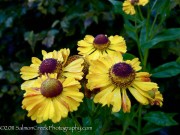
From the same group of seedlings that produced ‘Bruno’ comes ‘Coppelia’, the selection that holds first place in Alan Bloom’s heart for its earlier bloom and shorter stature. Large coppery red blooms supported by sturdy stems offer sumptuous colors for the late season border.
Blooms August–September.
Size: 3' 0" high x 18" wide.
Hardy to zone 4.
Helenium ‘Flammendes Käthchen’ (P-1185)
OUT OF PRODUCTION AT THIS TIME
Email me when this plant is available
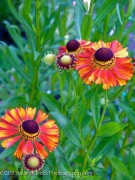
Long after other flowers have had their say, this tall, back-of-the-border Helenium delivers a bonfire of color. Henna-red and burnt orange petals, streaked with gilt hues, surround velvety brown centers, looking like the twirling skirts of flamenco dancers.
Blooms late August–mid-October.
Size: 5' 0" high x 2' 0" wide.
Hardy to zone 4.
OUT OF PRODUCTION AT THIS TIME
Email me when this plant is available
First discovered in the late 1800s, this robust and stalwart denizen of the American West volunteers a perky floral display above broad, up to a foot long, strapping foliage that creates a handsome gray-green rosette with a subtle sheen. Sturdy leafy stems yield vibrant clusters of 3 in. wide golden flowers defined by narrow, slightly reflexed rays circling a darker central disk.
Blooms July–August.
Size: 3' 0" – 4' 0" high x 18" – 2' 0" wide.
Hardy to zone 3.
Each $11.75
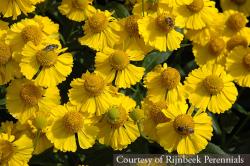
A top-performer at Mt. Cuba’s plant trials, this pollinator-friendly Karl Foerster prodigy touts merit aplenty and sunny good cheer. Copious bright canary-yellow flowers, among the best for cut creations, furnish frilly-edged horizontal petals plus deep yellow central cones that turn rusty orange in autumn and nourish the birds. Renowned for floral profusion, upright, thick-branched stalks and superior disease resistance, ′Kanaria′s clumping stand of lance-shaped greenery shuns deer, seldom needs staking and craves sunny adequately-moist abodes.
Blooms August–mid-October
Size: 3' 0" – 4' 0" high x 18" – 2' 0" wide.
Hardy to zone 4.
Helenium ‘Moerheim Beauty’ (P-0431)
Each $11.75
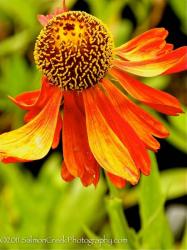
Enhancing gardens since 1930, this well-loved award-winning Helenium serves up a floriferous dose of long blooming, uniquely colored flowers. Daisy-like blossoms grab your attention as wedge-shaped dark copper red petals encompass mocha-hued central domes with gold rims. Shouldered by staunch upright stems and toothed slender green leaves, the pollinator-friendly blooms make quite a splash amid companions such as Heliopsis ‘GoldgrÜnherz’, Phlox ‘David’, Sanguisorba ‘Chocolate Tip’ and Molinia ‘Bergfreund’.
Blooms late August–mid October
Size: 2' 0" – 3-1/2' high x 18" wide.
Hardy to zone 4.
Helenium ‘Potters Wheel’ (P-2047)
Each $11.75
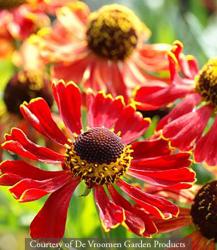
Selected by Dutchwoman, Inez Arnold, this hearty full-toned Helenium struts straight stems and attractive lanceolate green leaves that bolster a bevy of 2 in. wide, richly-hued blossoms. The large, open-faced deep red flowers are emboldened with dark chocolate-colored cones and a slender, radiant golden edge. Beloved by pollinators as well as floral arrangers, ‘Potter’s Wheel’ injects welcome late summer pizazz to mixed borders, cottage gardens and prairie-style plantings.
Blooms July–September
Size: 2-1/2' – 3-1/2' high x 18" wide.
Hardy to zone 4.
OUT OF PRODUCTION AT THIS TIME
Email me when this plant is available
Saturated with dusky red hues, uniquely shaded petals perform a lavish dance around prominent maroon and saffron hubs. Droves of closely set flowers, some marked by yellow tips, are esteemed for their long blooming period and the consistent color they maintain throughout the season, unlike many other Heleniums.
Destined to be a vivacious garden mainstay, this Bob Brown introduction grows as a bushy verdant clump, looks spectacular en masse and can escort perennials like Monarda ‘Jacob Cline’ and Salvia confertiflora for a galvanizing floral affair.
Size: 2-1/2' – 3' 0" high x 18" wide.
Hardy to zone 4.
Each $11.75
A dashing straight-backed German introduction, ‘Rotgold’s bicolored flowers flash deep red petals with bright sunny yellow margins plus prominent dome-like flaxen, maroon and chocolate-colored centers. Obovate 4 in. long medium green leaves anchor the sumptuous long blooming floral extravaganza that can cozy up to Veronicastrum ‘Red Arrow’, Phlox ‘Blue Paradise’ and Schizachyrium ‘Jazz’ in a meadow-inspired venue, prairie-style planting or perennial border.
Blooms July–September
Size: 3' 0" – 4' 0" high x 18" – 2' 0" wide.
Hardy to zone 4.
Helenium ‘Rubinzwerg’ (P-1483)
Each $11.75
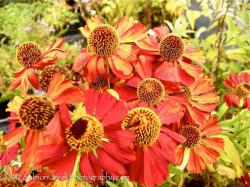
Plushly colored in chocolate brown and gold, each round hub centers a carousel of dark brick red petals, exhibiting orange-yellow striations as they age, while smooth-edged lanceolate leaves cloak the sturdy upstanding stems below. Wildly popular in Europe, this compact shorter statured Helenium makes a welcome addition to any garden, especially when showcased with Monardas and Panicums.
Blooms August–September
Size: 2' 0" – 2-1/2' high x 15" wide.
Hardy to zone 4.
Helenium ‘Sahins Early Flowerer’ (P-1700)
Each $11.75
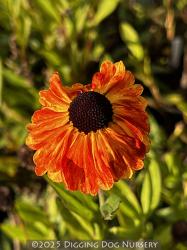
If razzle-dazzle is what you are looking for consider trying this festive AGM winner. Tidy, tapered green leaves and tall brawny stems hoist a bright celebration of multihued deep red flowers with gold and coffee-colored central knobs. Shortly after unfurling, the-perfect-for-cutting blooms manifest sparkling orange and sunny yellow streaks, each blossom unique in its pattern and combination of shades. Crocosmia "Lucifer" and Aconitum "Arendesii" make equally vibrant companions.
Blooms July–September
Size: 2-1/2' – 3' 0" high x 18" wide.
Hardy to zone 4.
Each $11.75
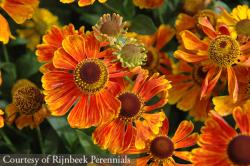
Revered by both pollinators and plant aficionados, this lusty large-flowering 1947 German introduction equally impressed the RHS back in 2001 when they unanimously granted it an AGM. Attractive, long, alternate green leaves plus straight strong stems carry a unique velvet textured flourish of 3 in. wide brown-centered flowers featuring artfully painted gold-hued petals dusted with copper and tangerine shades on top, and burnt orange on the flip sides. Ideal for mixed borders, cottage gardens and meadow settings, ‘Waltraut’ lends cozy late season colors alongside other easy-care plants such as Echinacea paradoxa, Veronicastrum ‘Adoration’ and Molinia ‘Moorflamme’.
Blooms July–September
Size: 3' 0" – 4' 0" high x 12" – 18" wide.
Hardy to zone 4.
Helenium ‘Zimbelstern’ (P-0854)
OUT OF PRODUCTION AT THIS TIME
Email me when this plant is available
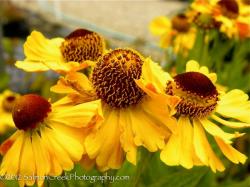
One of the largest flowered Heleniums, ‘Zimbelstern’s undulating, brilliantly golden, mahogany-splashed petals converge at a russet eye. Before its enthusiastic bloom, strong stems sport unusual chartreuse buds that have a joy all their own.
Blooms late August–mid-October.
Size: 4' 0" – 4-1/2' high x 18" wide.
Hardy to zone 4.

The clearest, brightest yellow, not at all pale and without a trace of gold, imbues the nearly 4 in. wide starry flowers of this willowy American native. Amazingly floriferous and versatile, the Aspen Sunflower is lower growing and earlier to bloom than its Helianthus counterpart.
Long, green and hirsute, straplike basal foliage blushes red come fall, while seed heads, waving on open branched sparsely leafed stalks, provide a banquet for the birds.
Originally collected in 1843 and dwelling throughout woodlands and stream sides from the “Aspen Belt” north to Wyoming and Montana, it will thrive in nearly any garden—semiarid or moist, sunny or a little shady—and makes a fine autumn bouquet with grasses and rosehips.
Blooms July – September.
Size: 3' 0" – 4' 0" high x 2' 0" – 2-1/2' wide.
Hardy to zone 3.
Helianthemum
Sun Rose
Evergreen subshrubs and members of the Cistus family, Sun Roses hail from the Mediterranean. Tolerant of drought and salt spray, they exhibit the general hardiness that makes them welcome in a rock garden. Let them cascade over a wall or some other sunny well-drained location. Tufted with yellow stamens, their fleeting, silky, rose-like blossoms provide a luminous and continuous display against small-sized matte foliage. Capable of quick infill, combine the Sun Roses with water-thrifty companions like Lavenders, select Euphorbias and Origanums.
Helianthemum ‘Belgravia Rose’ (P-1729)
Each $11.75

Noted as one of the earliest and most bountiful bloomers among our Helianthemum selections, ‘Belgravia Rose’ boasts a pretty showing of chiffon-like rose-pink flowers with sprightly yellow centers poised above fine textured sage-green leaves.
Blooms April–June
Size: 8" high x 18" wide.
Hardy to zone 4.
Helianthemum ‘Cheviot’ (P-1084)
Each $11.75
Helianthemum ‘Fire Dragon’ (P-1293)
Each $11.75
Helianthemum ‘Henfield Brilliant’ (P-0943)
Each $11.75
Helianthemum ‘Mesa Wine’ (P-1572)
Each $11.75
Close-knit reflective dark green leaves are buried by a generous supply of opulent wine-red flowers with sunshine-yellow stamens. Well suited for edging a border or topping a stone wall, ‘Mesa Wine’ promises intoxicating allure, especially when associated with Dianthus and Cistus ‘Tania Compton’.
Blooms May–July
Size: 8" high x 18" wide.
Hardy to zone 4.
Helianthemum ‘St. Mary’s’ (P-1339)
Each $11.75
Delicate soft pink blooms garnish the very silvery leaves of this Helianthemum. Contrast ‘Wisley Pink’s soft and fetching demeanor with fellow Mediterranean, Eryngium variifolium.
Blooms May–July
Size: 8" high x 18" wide.
Hardy to zone 4.
Helianthus
Sunflower
The sunflower was once an emblem of the Inca Sun God. This well-loved genus is 150 species strong and includes not only sprightly garden plants but commercially important food and oil crops. Our easy-to-grow selections make great cut flowers and attract bees plus tolerate a wide range of soil conditions.
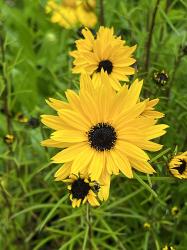
A cheerful mop of clustered golden yellow daisies crest towering, 6 ft. tall valiant stems guised with leathery needle-like rich green leaves. One of the last perennial Sunflowers to bloom, this striking American native flaunts copious large flowers, each defined by nearly 15 sun-stained petals encompassing a purplish brown cone. Hard to miss, even from a distance, the Swamp Sunflower’s brilliant persona can grace the perennial border, stylized meadow or butterfly garden, where it grows well among Asters and Schizachyrium, wards off deer and relishes sunny moist niches, but acquiesces to other conditions.
Blooms September–October
Size: 6' 0" high x 2' 0" – 3' 0" wide.
Hardy to zone 5.
Helianthus angustifolius ‘Gold Lace’ (P-1698)
Each $12.25
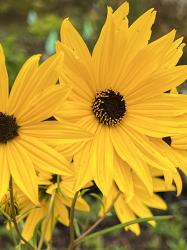
Rugged, slender and deep green, ‘Gold Lace’s fine textured leaves and strong stems frame a verdant lacy tower all season long. Magnificent, 2 in. wide golden yellow flowers burst open in such bold profusion that this undemanding U.S. native becomes the star of the late summer border, headlining an unbeatable grand finale. Adored by butterflies, gardeners and florists, ‘Gold Lace’ thwarts bunnies and dry conditions once established, doesn’t require staking or much fertilizer and looks absolutely sublime accompanying Asters and Molinias.
Blooms late September–October.
Size: 4' 0" – 5' 0" high x 2' 0" – 3' 0" wide.
Hardy to zone 6.
Originally discovered as a chance seedling at Matanzas Creek Winery in northern California and visible from literally ½ mile away, abundant pale yellow flowers cover the upper third of this extravagant perennial. Ours bask in their glory near the pond, along with other late bloomers like Salvia corrugata and Miscanthus ‘Adagio’.
Blooms September–early November
Size: 7' 0" high x 3' 0" wide.
Hardy to zone 6.
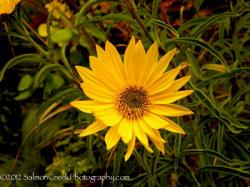
Noted horticulturist, David Salman from High Country Gardens kindly sent us this dazzling Helianthus ‘Lemon Queen’ and Helianthus maximiliana ‘Dakota Sunshine’ cross selected from seedlings originating at Lauren Springer and Scott Ogden’s Colorado residence. A vigorous selection for regions with short growing seasons, ‘Dakota Queen’ releases a buoyant flood of brilliant yellow daisies that crown tall stocky reddish stems clad in rough deep green linear leaves. Blooming by the middle of August, far earlier than most maximiliana species, its regal texture-rich visage is tough, reliable and capable of handling clay soil.
Blooms mid-August–early October
Size: 5' 0" – 6' 0" high x 3' 0" – 5' 0" wide.
Hardy to zone 4.
Late blooming pastel yellow flowers gaze down at onlookers from atop lofty, sturdy stems. Combine with Buddleja ‘Ellen’s Blue’, Calamagrostis ‘Karl Foerster’ and tall, late Asters in the rear of the border.
Blooms early August – October
Size: 6' 0" – 10' 0" high x 2' 0" – 3' 0" wide.
Hardy to zone 6.
OUT OF PRODUCTION AT THIS TIME
Email me when this plant is available
A celebrated American denizen often found in open woodlands, prairies and along roadsides, this Sunflower’s ebullient yellow face belies its resilient nature. The dense colony of upright wine-hued stems and rough lanceolate leaves can handle neglect, drought, and sun or shade.
Enticing to bees, butterflies, and gardeners alike, yellow 2 in. wide, broad-petaled and brown-centered blooms burst forth from round, spiky-looking green buds. Even though the long lasting jaunty display signals summer’s end, the good-sized chocolate-colored seed heads keep the birds happy and our interest sparked.
Blooms August–October.
Size: 5' 0" – 6' 0" high x 3' 0" wide.
Hardy to zone 3.
Helianthus laetiflorus ‘Lemon Queen’ (P-0535)
Each $12.25
Helianthus ‘Loddon Gold’ (P-2321)
Each $12.25
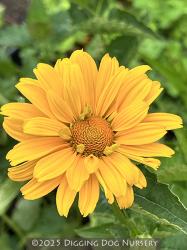
Big fully-double golden-yellow blossoms aloft an undemanding luscious base of textural dark greenery set this 1920 hybrid apart. Bolstered by upright sturdy stems plus pointy, rough-feeling, ovate leaves, the bountiful boisterous blooms tantalize butterflies and floral designers alike. Grateful for sunny, well-drained fertile abodes and a Chelsea chop in May, AGM-winning ‘Loddon Gold’ spangles mixed borders, prairie-style plantings and cottage gardens with glorious late season sass, especially when frolicking amid chums like Aster ‘Orpheus’ and Stipa calamagrostis.
Blooms August–September
Size: 4' 0" – 5' 0" high x 2' 0" – 3' 0" wide.
Hardy to zone 5.
Helianthus maximiliana ‘Santa Fe’ (P-1213)
Each $12.25
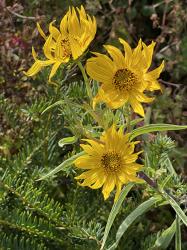
As summer fades into fall, this native New Mexican sunflower bursts into abundant bloom with gorgeous large, golden yellow flowers. Dark green, long and narrow pointed leaves create an eye-catching colonnade several months before the top half of each red-tinged, sturdy stem gives way to closely arranged, fulgent daisies. Putting on one of the latest and unequivocally finest autumn displays, regal ‘Santa Fe’ stands in sharp relief to the violet-hued Aconitums in our border.
Blooms September–October
Size: 6' 0" – 8' 0" high x 3' 0" wide.
Hardy to zone 4.
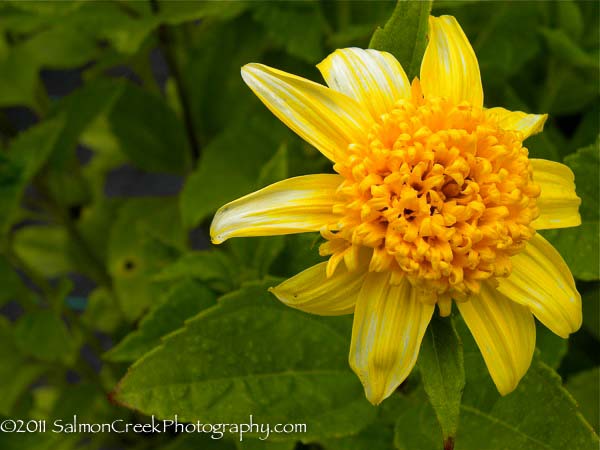
Touted as one of the best late flowering perennials and considered a shining star amongst other Helianthus, ‘Capenoch Star’ headlines big-centered, large lemon- yellow blooms borne in cheerful abundance. Tidy forest green leaves bolster the sunny display, which bears some semblance to its annual cousin and looks positively radiant with a sweep of frothy white Persicaria polymorpha and Salvia ‘Blue Ensign’ in Great Dixter’s long border.
Blooms August – October.
Size: 4' 0" – 5' 0" high x 2' 0" – 3' 0" wide.
Hardy to zone 4.
Helianthus salicifolius (P-0650)
Each $12.25
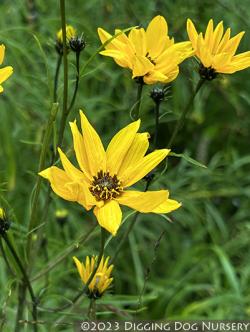
Found on prairies, dry sites and calcium-rich environs from Missouri through Oklahoma to Arkansas and Texas, this sky-bound willow-style Sunflower entertains a no-fuss, graceful flourish of pendulous, ultraslender, 7 in. long pale green leaves on smooth, staunch whitish green stalks. The exotic-looking feathered foundation boosts loosely branched racemes with copious 2 in. wide, bright yellow sunflowers that don coffee-brown centers. Adored by birds and butterflies, but not deer, Helianthus salicifolius lends flower-power galore plus lofty fine-textured accents to cut arrangements, naturalized plantings, a border’s backside and fellow late-blooming perennials such as Salvia uliginosa and Aster ‘Violetta’. A mid-spring cutback ensures a stronger, more upright habit.
Blooms September–October
Size: 6' 0" – 8' 0" high x 2' 0" – 3' 0" wide.
Hardy to zone 4.
Heliopsis
False Sunflower
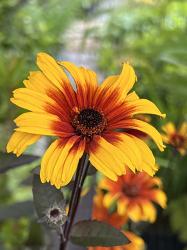
An intrepid color-rich perennial, this Heliopsis hosts purple-infused new growth plus eggplant-hued stems beneath a long-lasting sunburst of yellow flowers enhanced by mocha-colored centers and maroon splashes at each petal’s base. Alluring ovate dark green leaves with serrated margins garb the stiff upright stems that seldom need staking. Popular among birds, butterflies and flower arrangers, ‘Prairie Sunset’s handsome clumping profile can grace sunny perennial borders, native plantings and prairie-style gardens. It looks best en masse, fends off most diseases and abates erosion, while tolerating urban pollution, shallow, rocky or clay soil, as well as moist and dry sites.(PP# 13,779)
Blooms June–September
Size: 3' 0" – 5' 0" high x 2' 0" – 2-1/2' wide.
Hardy to zone 4.
As the German namesake suggests, this double-flowering selection of the valiant North American native fashions terminal clusters of 2 to 3 in. wide, densely petaled bright yellow flowers with greenish yellow centers. The splendid floral display beguiles butterflies and songbirds all summer perched atop sturdy stems and attractive, serrated, lance-shaped dark greenery. An adaptable 1934 Karl Foerster introduction that appreciates superb drainage, ‘GoldgrÜnherz’s lucent upright clump can be featured amid Phlox paniculata ‘Nicky’ and Liatris ‘Alba’ in perennial borders, meadow-style vignettes or cottage gardens. Deer, dry conditions, clay or rocky soil and otherwise infertile sites do not deter it.
Blooms July–September
Size: 3-1/2' – 4' 0" high x 2' 0" – 3' 0" wide.
Hardy to zone 4.
Flashing a brilliant late season cornucopia of deep golden yellow daisies with mahogany-colored discs, this North American Helianthus relative sprouts slender red-infused branching stalks and opposite hairy leaves enriched by bronzy wine shades. A colorful North Creek Nursery selection, ‘Summer Nights’s tall sturdy stems yield marvelous long-lasting flowers that tantalize florists, songbirds and butterflies, yet easily fend off pests and occasional drought. False Sunflower’s versatile, dependable and no-fuss persona is well-suited for the middle of the border, a shrubby planting or even a less formal venue. It seldom needs staking, appreciates well-drained, somewhat moist fertile sites, and regular deadheading.
Blooms July–September
Size: 3' 0" – 4' 0" high x 2' 0" – 3' 0" wide.
Hardy to zone 4.
Helleborus
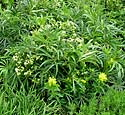
Christmas Rose/Lenten Rose
Stories about this genus are countless. In medieval times, it was considered a weapon against witches, madness and evil spirits. Hellebores deserve a place in every garden, not only because of their supposed power, but because they bloom for a long time, early in winter, when the weather is cool and many plants are still dormant. Most like moist, loamy soil with lime and leaf mold. We like them as ground covers for deciduous shrubs, conifers, or broad-leafed evergreens, and when possible plant them in an elevated spot to admire their flowers.
Helleborus argutifolius (P-0087)
Each $12.50
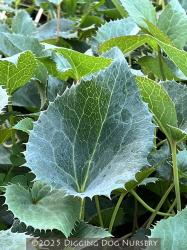
Headlining large racemes of cup-shaped light green flowers nodding well above a bushy subshrub-like foundation, this attractive native of Corsica and Sardinia is one of the largest Hellebores. Stout stems generate substantial gray-green foliage with spiny-toothed margins, long celery-colored petioles and a polished finish. Try it as a backdrop for Epimedium ‘Orange Queen’, Brunnera and Pulmonarias.
Blooms February–April
Size: 18" – 2' 0" high x 2' 0" wide.
Hardy to zone 6.
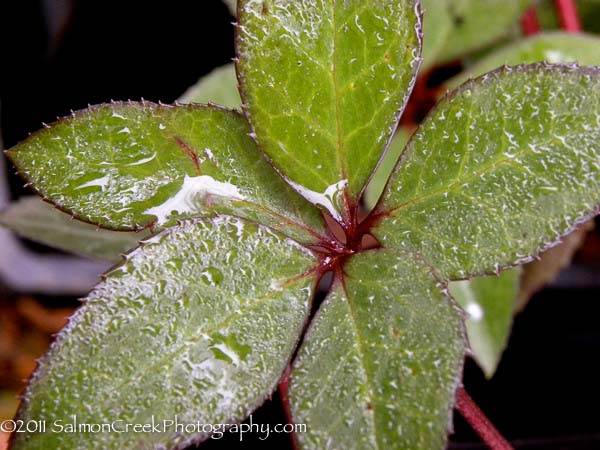
Hybridized by German plantsman, Josef Heuger, ‘Pink Frost’ boasts a captivating floriferous display and a versatile hearty evergreen habit. A multicolored effect is created as legions of burgundy buds unfurl antique-toned pink petals, which encompass blonde stamens, and eventually mature to a deeper rosy red. Forging a forest-green clump of thick, small-toothed, red-petioled leaves, this Helleborus lividus and Helleborus niger progeny is tailor-made for containers and obliges a wide range of light exposures including deep shade, full sun and everything in between. (USPPP)
Blooms January–March
Size: 9" – 15" high x 18" wide.
Hardy to zone 5.
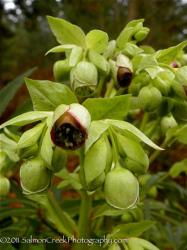
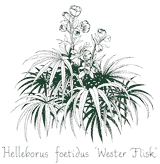
From the banks of Scotland’s Tay River, ‘Wester Flisk’s fantastic foliar effect and extraordinary coloration will leave you spellbound. Large finely dissected palmate leaves with narrow jagged-edged finger-like leaflets interlace in a singular geometric fashion, creating a dark grayishgreen dome that casts maroon shades from fall to spring. Set off by red-infused stems and stalks, the airy chartreuse clusters of perfectly shaped bell flowers are rimmed in red. This exceptional selection maintains its composure when exposed to sun or shade, rabbits and deer, plus dry, moist or clay soil.
Blooms February–April
Size: 18" – 2' 0" high x 18" wide.
Hardy to zone 5.
Helleborus ‘Grape Galaxy (Winter Thriller™)’ (P-1887)
OUT OF PRODUCTION AT THIS TIME
Email me when this plant is available
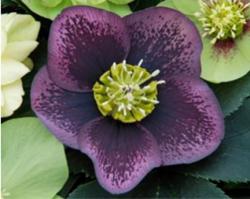
Modeled on tall strong stems above varnished evergreen foliage, the large ornately marked grape purple flowers showcase contrasting bright green nectaries surrounded by prominent dusky violet freckles. Chris Hansen’s discerning eye selected this remarkable Hellebore strain for its vibrant legions of otherworldly 3 ½ in. blooms and its fetching deep green visage that possesses amazing vigor.
Blooms January–March
Size: 18" – 2' 0" high x 0" wide.
Hardy to zone 4.
Helleborus ‘HGC Diva’ (P-2209)
Each $17.75

This deluxe long-lived Heuger Hellebore earns her diva status as copious, extralarge and slightly cupped crisp-white blooms appear just after Thanksgiving. Donning subtly pink stigmas, the early outward-facing flowers unfurl from soft rose-imbued buds atop a shapely evergreen bed of stout stems plus thick palmate forest-green foliage that’s festooned with reddish leaf petioles. Whether in a woodland setting, prized patio container or cut floral centerpiece, ‘Diva’ guarantees both gusto and grace.
Blooms December–March
Size: 12" high x 18" wide.
Hardy to zone 5.
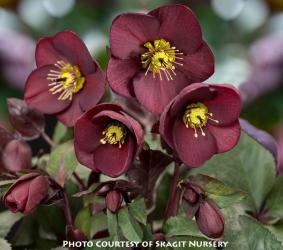
A complex German hybrid consisting of Helleborus niger, Helleborus sternii and Helleborus hybridus, ‘Merlot’s large rounded forward-facing flowers flaunt a luxe velvety wine-hued aspect. Brightened by ebullient sunshine-colored stamens, the clustered long-blooming display dwells atop staunch erect reddish stems plus broad durable deep green foliage that’s chiseled into hand-like evergreen segments. Heady saturated colors coupled with a dignified year-round persona give you good reason to welcome this first-class HGC series member into your winter garden. (pp#31,181)
Blooms December–March
Size: 15" – 18" high x 18" – 2' 0" wide.
Hardy to zone 5.
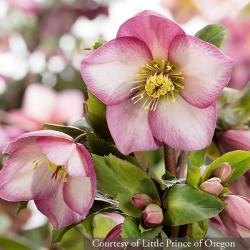
A meticulously crafted cross from Josef Heuger’s Gold Collection, this easy-care Helleborus x ericsmithii and Helleborus x hybrida introduction promotes impressive vigor, longevity and flower power. Extra-large outward-facing single blooms showcase icy pink overlapping petals with dark pink edges and backsides, while prominent canary-yellow centers add a zingy grace note. Poised on stout reddish stems, glamorous pretty-in-pink posies are cushioned by a lustrous evergreen bed of thick, deeply cut lobes.
Blooms November–mid-February
Size: 15" – 18" high x 18" – 2' 0" wide.
Hardy to zone 5.
Helleborus x hybridus (P-0243)
OUT OF PRODUCTION AT THIS TIME
Email me when this plant is available
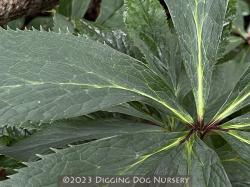
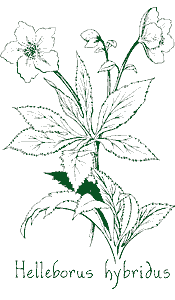
Perhaps one of the finest low growing, early flowering plants, this Helleborus is easy to grow, requiring only shade and some moisture. The nodding flowers, which range in color from blush white to plum, are usually spotted on the inside with crimson and maroon. Lustrous and dark green, the 12 in. wide evergreen leaves are divided into seven to nine segments.
Blooms January–April
Size: 18" high x 2' 0" wide.
Hardy to zone 4.

World-renowned Hellebore breeder Marietta O’Byrne earns kudos for this woodland diva’s large flouncy double flowers. A variable carousel of colors, each extraordinary yellow bloom features rumpled peach and rose-blushed petals that are often trimmed with red or hot pink picotee margins, creating an overall cozy amber shade. The lucent floral display sojourns atop a regal evergreen foundation defined by robust, polished forest-green foliage.
Blooms February–April
Size: 15" – 20" high x 18" – 2' 0" wide.
Hardy to zone 5.
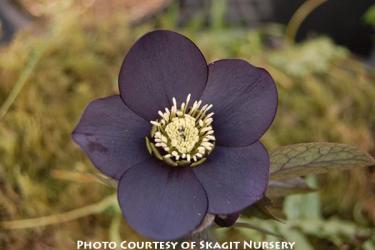
Mustering a mysterious wintertime element for shady nooks, large cup-shaped single blooms present pearlescent centers encompassed by seductive shades of dark violet, purplish burgundy, smoky midnight and nearly black. The ultraluxe floral profusion tops firm dark mahogany stalks and beefy palmate evergreen leaves that sculpt a gleaming deep green mound. Named Perennial Plant of the Year in 2005, this valiant Marietta O’Byrne seed strain can lounge alongside Asplenium ‘Cristatum’ and Cyclamen coum.
Blooms February–April
Size: 15" – 18" high x 18" – 2' 0" wide.
Hardy to zone 5.
Helleborus x hybridus ‘Blue Metallic Lady’ (P-1617)
OUT OF PRODUCTION AT THIS TIME
Email me when this plant is available
Deemed some of the finest low growing, early flowering plants, the hybridus Hellebores are easy to grow, requiring only shade and some moisture, and those in the “Lady” series, innovated by Gisela Schmiemann, are renown for their beauty. ‘Blue Metallic Lady’s darkly alluring, cupped and upfacing flowers boast lavish midnight purplish blue hues with merlot and pewter overtones and a bright cluster of champaign-colored stamens. Lustrous and dark green, the broad evergreen leaves are divided into 7 to 9 segments.
Blooms February–March
Size: 15" – 18" high x 18" wide.
Hardy to zone 5.
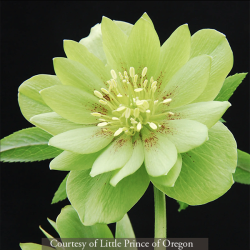
Perhaps you could use a profusion of exotic-looking Lotus-style blooms to spruce up your wintertime garden. If so, consider this recent Marietta O’Byrne seed strain that swaggers large, fully double jade-green flowers embellished with burgundy-toned picotee edges plus ruby-infused streaks, speckles and dapples. Varying in color and markings, the fluffy yet sophisticated floral display lasts for several months atop stocky stems and a resilient, lustrous evergreen clump.
Blooms February–April
Size: 18" – 22" high x 18" – 2' 0" wide.
Hardy to zone 5.
Helleborus x hybridus ‘Mardi Gras Slate Shades’ (P-1734)
OUT OF PRODUCTION AT THIS TIME
Email me when this plant is available
One of the prized outcomes from Charles Price’s complex breeding programs, this new Hellebore offers darkly alluring, cupped and upfacing flowers, which boast charcoal hues suffused with blue, plum and wine tones and sprightly champaign-colored stamens. Broad dark green leaves are divided into 7 to 9 segments and retain their lustrous finish throughout the year.
Blooms January–March
Size: 15" – 18" high x 18" – 2' 0" wide.
Hardy to zone 5.
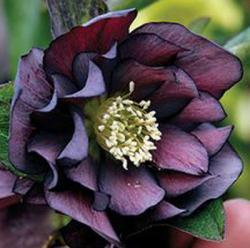
Applauded as the most successful black double-flowering hybrid on the market, the 3 in. wide nodding flowers, hosted atop a glossy evergreen habit, flaunt sumptuous color for several months. Up to 20, ultraswank ruffle-edged petals glisten in beckoning shades that range from smoky-plum, slate-purple to nearly black, while encompassing frilly champagne-colored centers. Longevity, superb vigor and dark reddish new growth are the hallmark of this divine Marietta O’Byrne seed strain.
Blooms January–April
Size: 18" – 2' 0" high x 18" – 2' 0" wide.
Hardy to zone 5.
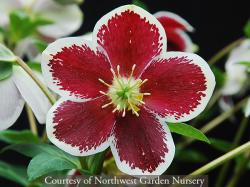
Hats off to Oregon’s Marietta O’Byrne and her impressive Helleborus breeding program for introducing this fanciful easily grown selection. Festooned with eye-catching freckled and blotched burgundy-colored centers, single rounded creamy-white flowers are showcased against a composed, leathery dark green ensemble. The multitude of long-lasting blooms enlivens shady garden alcoves and can be surrounded by Dicentra ‘Bacchanal’ and Ajuga ‘Black Scallop’.
Blooms January–April
Size: 15" – 20" high x 18" – 2' 0" wide.
Hardy to zone 5.
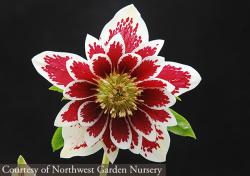
Masterfully bred by Marietta O’Byrne, this rococo cultivar rallies big fully-double alabaster-colored blossoms tattooed with bold centrally-located maroon to purplish red splashes, streaks and stipples. Lustrous deeply-lobed leather-like leaves create a dapper bushy dark green foil for the marvelous floral gala. ‘Painted Doubles’s upright evergreen mound can rollick amid other easy-care perennials such as Polystichum setiferum ‘Herrenhausen’ or Brunnera ‘Mr. Morse’.
Blooms January–April
Size: 15" – 18" high x 18" – 2' 0" wide.
Hardy to zone 5.
Another stellar Hellebore from the highly touted Lady series, ‘Picotee Lady’ affords ample feminine appeal with stylish uniquely etched blooms. The cup-shaped greenish white flowers model rosy-wine rims, pink or red veins, darker pink flip sides and a starburst of flaxen stamens. Thick lightly toothed deep green leaves craft a dark glistening foundation that’s easily grown and relished nearly all year, especially when planted next to Pulmonaria ‘Diana Clare’.
Blooms January–April
Size: 14" – 18" high x 18" wide.
Hardy to zone 5.

Yet another ravishing O’Byrne Hellebore seed strain, this evergreen headliner hosts variable single Anemone-style white flowers with rosy-rimmed petals plus eye-catching ruffled pearlescent centers. The pronounced semidouble central hubs are distinguished by either deep pink, red-violet or burgundy margins, and often merlot-colored striations. Voted the 2005 Perennial Plant of the Year, ‘Picotee Pearl’s long-lasting floral splendor illuminates tasteful, toothed shiny bright green foliage that can gambol alongside Polystichum polyblepharum and Pulmonaria ‘Diana Clare’ for a wondrous winter-time vignette.
Blooms January–April
Size: 18" – 22" high x 18" – 22" wide.
Hardy to zone 5.
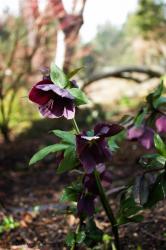
Earning the Perennial Plant of the Year award in 2005, this Gisela Schmiemann innovation is renown for its outward facing dusky reddish violet flowers. The alluring dark blooms, heightened by spry light-colored stamens, are clustered above a glossy evergreen bed of thick, toothed and segmented dark green leaves. ‘Red Lady’s mysterious flair can be associated with other coddle-free woodland dwellers such as Beesia deltophylla and Omphalodes ‘Starry Eyes’.
Blooms January–March
Size: 15" – 18" high x 18" – 2' 0" wide.
Hardy to zone 5.
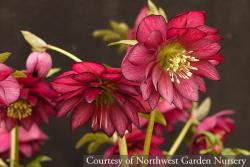
A decadent balm for gardeners who dread winter, this lusty Marietta O’Byrne cultivar swaggers profuse double-petalled dark rosy-red and crimson blooms—good-sized, cupped and nodding. The richly hued blond-eyed Lotus-style blooms dally on staunch stems rising above a well-formed evergreen mass of glistening serrated dark green leaves. Intermingle undemanding ‘Red Sapphire’ with ‘Double Painted Lady’ for enticing cold-weather color echoes and contrasts.
Blooms February–April
Size: 15" – 18" high x 18" – 2' 0" wide.
Hardy to zone 5.
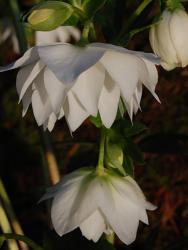
Another Marietta O’Byrne marvel, this exquisite hand-pollinated seed strain is reputed to be the best double white Hellebore currently available. Gathered like folds of chiffon around a green eye, the large, fully double pure white flowers are 3 in. wide and pendulous, yielding over 40 blooms per plant. The luxe display brings scintillating luminosity to ‘Sparkling Diamond’s enduring prowess and verdant evergreen leaves.
Blooms February–April
Size: 15" high x 18" wide.
Hardy to zone 5.
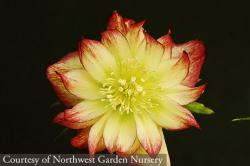
Beaming large pale yellow to golden-yellow double flowers with rosy-red picotee margins and streaks, this hand-pollinated O’Byrne seed strain is guaranteed to chase away the winter blues. Perky butter-colored stamens and a green central glow garnish the aptly named cheerful blooms that top strong stems plus a polished, bushy Yew-green base of energetic evergreen foliage. The ornate, outward-facing wavy-petalled flowers make a fulgent counterpoint to Pulmonaria ‘Bertram Anderson’s silver-dappled leaves and blue blossoms in shady garden niches.
Blooms January–April
Size: 15" – 18" high x 18" – 22" wide.
Hardy to zone 5.
Helleborus x hybridus ‘White Lady Spotted’ (P-1340)
OUT OF PRODUCTION AT THIS TIME
Email me when this plant is available
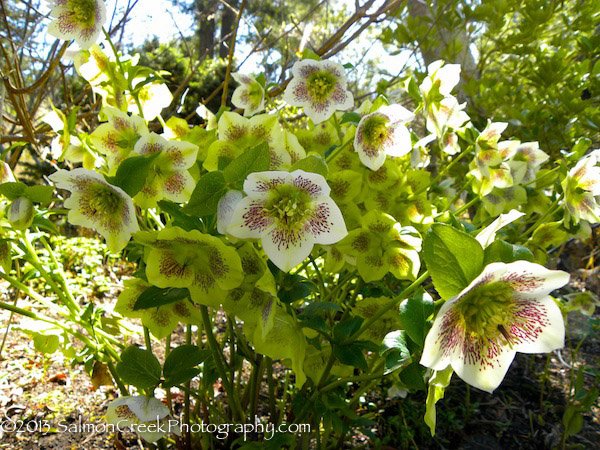
This elegant empress will take command of your winter garden. Warmed by a maroon freckled center and distinctively showcased against a dark green, thick-leafed evergreen base, each beautiful rounded white blossom appears to be sculpted from snow. Her glorious bearing is the result of Germany’s Gisela Schmiemann’s outstanding Hellebore breeding program.
Blooms January–April.
Size: 14" – 18" high x 18" wide.
Hardy to zone 5.
Helleborus x lemonnierae ‘HGC Madame Lemonnier’ (P-2019)
OUT OF PRODUCTION AT THIS TIME
Email me when this plant is available
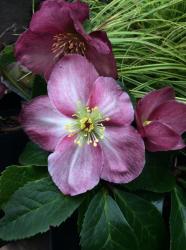
Hailing from Martine Lemonnier’s Normandy garden, this delightful newly introduced hybrid sprung up as a chance H. niger and H. hybridus seedling. Substantial, forward-facing plum-pink flowers, each with a central boss of butter-colored stamens, are lifted by tall staunch stems and a fuss-free dark green visage. ‘Madame Lemonnier’s gorgeous sterile blooms unfurl for months beginning in January, while her robust leaves make a classy year-long statement. (pp#25,646)
Blooms November–February
Size: 16" high x 18" – 2' 0" wide.
Hardy to zone 5.
Helleborus ‘Midnight Ruffles’ (P-1760)
OUT OF PRODUCTION AT THIS TIME
Email me when this plant is available
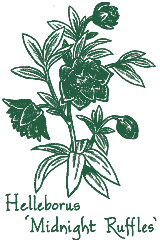
Flaunting three times the petals of most Hellebore blossoms, large lusty black double flowers, enhanced by buttery yellow stamens, distinguish this marvelous new Chris Hansen introduction. Borne on strong stems, the swank outfacing blooms, which span over 3 in., maintain their splendor for twice as long as their single flowering counterparts and unleash tantalizing drama into any garden setting. Rare, highly coveted, and deer-proof, ‘Midnight Ruffles’ also furnishes glossy good-looking evergreen foliage for your year-round enjoyment.
Blooms January–March.
Size: 18" – 22" high x 2' 0" wide.
Hardy to zone 4.
Helleborus niger ‘HGC Jonas’ (P-1806)
OUT OF PRODUCTION AT THIS TIME
Email me when this plant is available
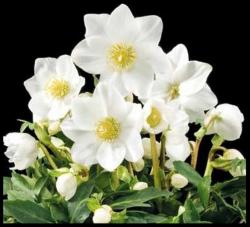
Promising early winter floral magic, this superbly bred selection boasts a luminous bevy of yellow-stamened crisp white petals atop burgundy stems. Defined by 7 petals, as opposed to the usual 5, and a light green or blush pink coloration as they age, full forward-facing flowers rise from dark green toothed leaves that shape a lustrous evergreen foil. Perfect for holiday decorating, ‘Jonas’ can be enjoyed in bouquets, in a lightly shaded mixed planting or a magnificent container specimen on the patio.
Blooms November–January
Size: 12" high x 18" – 2' 0" wide.
Hardy to zone 5.
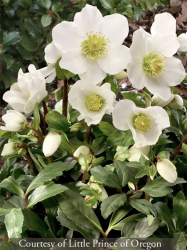
Coveted for their early bloom, the large outward-facing cupped white flowers with golden stamens foster a glamorous long-lasting flurry that arrives just in time to sparkle up the holidays. The subtly scented bee-friendly blossoms unfurl from November through the new year, transmuting pastel green shades as they age, above a resilient close-knit habit of thick varnished dark green palmate leaves. Introduced by Germany’s acclaimed Hellebore breeder Josef Heuger, ‘Jacob’ lends an indispensable easy-care evergreen presence to patio containers, shady borders and woodland gardens. (pp#17,799)
Blooms December–March
Size: 12" high x 18" wide.
Hardy to zone 5.
Helleborus niger ‘HGC Joseph Lemper’ (P-2020)
OUT OF PRODUCTION AT THIS TIME
Email me when this plant is available
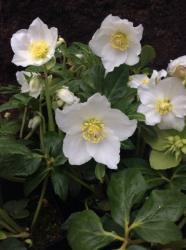
Highly acclaimed for his upright vigorous habit, long bloom period and early, outward-facing flowers, ‘Joseph Lemper’ touts the largest stature in the Gold Collection, a recent Dutch series of improved niger cultivars. The plenteous, 3 in. wide, somewhat cupped, pure white blooms are centered with decorative flaxen stamens, while crowning sturdy stems and dashing, thick, evergreen forest-hued foliage. (pp#15,615)
Blooms November–February
Size: 18" high x 18" – 2' 0" wide.
Hardy to zone 5.

Also known as Helleborus x nigersmithii ‘Walhelivor’.
With dark dusky pink buds and outward facing, easy-to-view ivory-petaled blooms, this vigorous Lenten Rose is aptly named. Innovated by the truly gifted English breeder David Tristram, and vegetatively propagated, ‘Ivory Prince’s exquisite flowers reveal a subtle infusion of colors, from soft green and antique rose on the inside to earthy plum hues on the exterior. Sturdy wine-tinted stems and princely, deep green leatherlike foliage marked by light prominent veining and toothed margins maintain a pleasing evergreen presence all year long.(PPAF)
Blooms March–April.
Size: 12" high x 18" – 2' 0" wide.
Hardy to zone 5.
Helleborus ‘Red Racer’ (P-1761)
OUT OF PRODUCTION AT THIS TIME
Email me when this plant is available
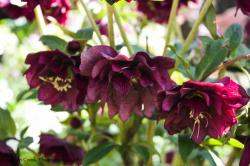
After 15 years of meticulous record keeping and careful hand crossing by American breeder, Chris Hansen, this vigorous richly colored Hellebore is the first selection to be released from the Winter Thriller series. Enormous 3 ½ in. wide, long lasting mahogany red flowers are perfectly rounded, as sumptuous as velvet and copiously produced, exceeding some 70 per plant. Poised on sturdy pencil thick stems, the glamorous outfacing blooms showcase bright platinum-colored stamens, and when mature, transmute unusual green hues well above the evergreen bed of thick, dark lustrous leaves.
Blooms January–March.
Size: 18" – 22" high x 2' 0" wide.
Hardy to zone 4.
Helleborus ‘Sunshine Ruffles’ (P-1843)
OUT OF PRODUCTION AT THIS TIME
Email me when this plant is available
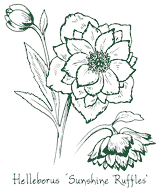
Beaming large sunny yellow double flowers with magenta-laced margins, this vigorous Chris Hansen cultivar introduces a new floral color to his Winter Thriller Hellebore series. Perky bright green nectaries embellish the aptly named cheerful blooms, which can number up to 50 or more, atop strong stems and a shiny Yew green bushy base of winning evergreen foliage. The ruffled flowers make a fulgent counterpoint to Pulmonaria ‘Bertram Anderson’s silver-dappled leaves and blue blossoms in shady garden niches.
Blooms January-March
Size: 18" – 22" high x 2' 0" wide.
Hardy to zone 4.
Hemerocallis
Daylily
Named for the fleeting nature of their 6-petaled trumpet-like blossoms, Daylilies are hardy and easy to grow. Their strap-shaped leaves arch gracefully to form clumps of brilliant green. Our selections are deciduous.
Each $12.75
Cultivated since 1902, this amenable Chinese denizen presents splendid lemon-toned flowers well above a compact dark green fountain of lustrous tailored foliage. The nocturnal 6 in. wide blooms open late in the day, welcoming butterflies and plant purveyors alike with narrow recurved petals, a pronounced trumpet shape and a lovely fragrance. Well-suited for the rockery, cottage garden or an adequately-drained mixed border, pest-free Hemerocallis citrina tolerates bunnies, air pollution plus an array of garden soil.
Blooms June–July
Size: 3' 0" – 4' 0" high x 18" – 2' 0" wide.
Hardy to zone 3.
Each $12.75
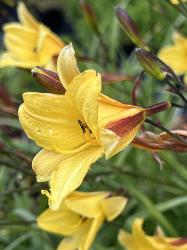
This dwarf Daylily has a refined and dainty, yet in some ways, exotic look. Persistent, richly colored brown buds and mahogany-striped, deep yellow flowers grace numerous branched stems arising from bright green, narrow foot high leaves. With its unusual blend of yellow and mahogany, ‘Corky’ can be celebrated en masse in a bed or individually in the rock garden.
Blooms mid-June – late July.
Size: 20" high x 12" wide.
Hardy to zone 4.
Hemerocallis lilioasphodelus ‘’ (P-2148)
Each $12.75
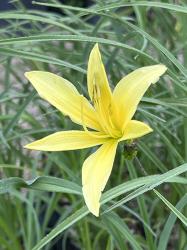
Gracing gardens since the 16th century, lovely lily-style bright lemon-yellow flowers promise a sweet fragrance and the earliest bloom time. Shiny strap-like bright green leaves describe a verdant semievergreen mass beneath dozens of narrow-petaled, 3 to 4 in. long blossoms, which are popular in Asian cuisine and favored by hummingbirds. This robust Chinese native can be planted near pathways, massed in mixed borders or allowed to naturalize, where it complements blue-flowering perennials, wards off bunnies and smothers weeds.
Blooms July–August
Size: 2' 0" – 3' 0" high x 2' 0" – 3' 0" wide.
Hardy to zone 3.
Hemerocallis middendorffii (P-1318)
Each $12.75

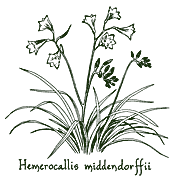
Delivering a radiant lightly perfumed performance, 6-petaled golden-orange flowers unfurl from chocolate-brown tinged buds. The tightly clustered cup-shaped blooms and prominent bracts are poised above a low-growing ornamental clump of narrow and arching, grassy-green blades that remain evergreen in warmer locales. Acquiescent to periodic dry conditions once established, this northeast Asian native affords a fresh or wilted culinary delicacy plus enhances containers, pathway edges, ponds and bouquets.
Blooms May–July
Size: 2' 0" – 2-1/2' high x 18" – 2' 0" wide.
Hardy to zone 4.
Hemerocallis ‘Speak of Angels’ (P-0538)
Each $12.75
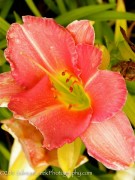
Conjuring angels colored by children’s crayons, as many as 25 soft pink blooms festoon each stem. Each 6 in. wide flower showcases undulating margins and a halolike lavender band that rims the long, vibrant chartreuse throat above a bed of arching sword-shaped blades.
Blooms June – July.
Size: 2' 0" high x 2' 0" wide.
Hardy to zone 4.
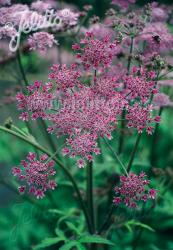
Applauded as one of the most exquisite pink umbels available, this 2016 Jelitto introduction premiers an airy pollinator-haven of flat-topped, dusky rose-colored blooms and deep pink buds on branched stems. The cut-flower-perfect, 8 in. wide posies float above lofty solid stalks anchored by a textural bright green mound with massive, lusty lobed leaves. Appreciating fertile, well-drained abodes and adequate moisture, ′Pink Cloud′ can be planted, either singularly or en masse, in mixed borders or natural-style gardens, where it promises summer-long flowers plus grandeur galore.
Blooms June–September
Size: 3-1/2' – 4-1/2' high x 16" – 18" wide.
Hardy to zone 3.
Heuchera
Coral Bells
Maple-like leaves form a dense evergreen base for long slender stems lined with small, urn shaped flowers, ranging in color from white to pink to chartreuse. Heucheras are extremely durable, despite their delicate, even dainty appearance. Long-lived and occasionally drought tolerant, they are appropriate to virtually any garden situation.
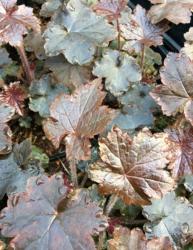
Smooth ultradark foliage, burnished with a gem-like luster, is this Heuchera’s stylish signature. Celebrating more vigor and more black than its deeply colored rival, Heuchera ‘Obsidian’, elegant lobed leaves fashion a compact mound, which offsets urn-shaped creamy white flowers. Utilize ‘Blackout’ as a mysterious midnight-hued springboard for golden grasses, yellow-leafed perennials, Japanese Painted ferns and silvery Pulmonarias. (pp#25,280)
Blooms May–June
Size: 16" high x 18" wide.
Hardy to zone 4.
Heuchera x brizoides ‘Weston Pink’ (P-0091)
Each $11.25
Overtop a trim mound of polished leaves, tall spires flaunt exceptional dusty pink flowers that easily meld with other perennials—a plus for this choice long-lived cultivar and for the garden designer. Surround ‘Weston Pink’ with diverse colors: lavender and blue Geraniums, yellow Kniphofias and Achilleas. Plant a large swath for visual impact and for arrangements as well.
Blooms April–July.
Size: 18" high x 18" wide.
Hardy to zone 4.
Heuchera ‘Coral Bouquet’ (P-0539)
OUT OF PRODUCTION AT THIS TIME
Email me when this plant is available
A highly welcome, more compact cultivar, ‘Coral Bouquet’ bears bright coral-colored blossoms several times bigger than most Heucheras. Mounding, mottled green foliage serves as an attractive, low growing foil for the springtime profusion of showy flower clusters.
Blooms April–June.
Size: 20" high x 18" wide.
Hardy to zone 4.

A cherished British cultivar with timeless appeal, widely acclaimed ‘Palace Purple’ earned the 1991 Perennial Plant of the Year title for its posh, lustrous maple-style leaves and delicate-looking airy panicles. The large, long-petioled foliage emphasizes olive-green, vibrant bronzy purple and burgundy shades on top plus beet-red undersides, while lithe, 18 in. tall wine-colored stems lift the petite pinkish white bells, enthralling butterflies and gardeners alike. Celebrated as one of the first Heuchers to be hybridized from a purple-leafed native, this low-growing semievergreen perennial begs bright shade and superb drainage, looks ultra-luxe en masse and promises contrasting foliar tones for a border, rockery, pathway’s edge, woodland garden, container and even a bouquet.
Blooms June–July
Size: 12" – 20" high x 12" – 18" wide.
Hardy to zone 4.
OUT OF PRODUCTION AT THIS TIME
Email me when this plant is available
Like shiny slabs of jet-black obsidian, smooth ultradark leaves achieve a gem-like luster, while shrouding an elegant compact mound. Dapper foliage, touted as the blackest of all—rounded, lobed and long-petioled—holds its seductive ebony and midnight-maroon coloring through full sun and hot, humid weather. Heightened by tall, supple red-tinted stems with small creamy flowers, reliable ‘Obsidian’ becomes a deep mysterious springboard, accentuating gilt-leafed grasses and perennials, the silvery fronds of Japanese Painted ferns plus spotted Pulmonarias. (pp#14,836)
Blooms June–July
Size: 2' 0" high x 16" wide.
Hardy to zone 4.
Heuchera pulchella ‘Raspberry Regal’ (P-0389)
Each $11.25
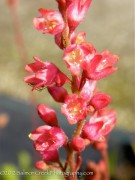
Excellent for cutting, these tightly clustered, deep rosy pink flowers open from dark, raspberry-red buds held on strong, upright stems that rise 2-½ ft. above the leafy mound of basal foliage. The robust leaves are deep green and sometimes subtly mottled with silver. To ensure cool, moist soil and ample sun, we plant this Heuchera on the edge of our woodland border and back it with Persicaria amplexicaulis ‘alba’.
Blooms June–August.
Size: 3' 0" high x 2' 0" wide.
Hardy to zone 4.
Heuchera sanguinea ‘Apple Blossom’ (P-0299)
OUT OF PRODUCTION AT THIS TIME
Email me when this plant is available
Lush verdant foliage offers a dramatic counterpoint to this Heuchera’s uniquely bicolored flower, which is snowy white with a pink-blushed lip. Elevated on 8 to 12 in. tall stems, the blossoms look especially cheerful next to blue blooming Nepetas.
Blooms April–June.
Size: 18" high x 18" wide.
Hardy to zone 4.
Heuchera ‘Santa Ana Cardinal’ (P-1702)
OUT OF PRODUCTION AT THIS TIME
Email me when this plant is available
A superb evergreen cross between Heuchera maxima and Heuchera sanguinea, this vigorous dazzler was introduced in 1958 by the Rancho Santa Ana Botanical Garden. Scalloped bright green leaves describe a dense lustrous base, showcasing the generous offering of vivid rosy red bells on 2 ft. tall flowering spires.
Tantalizing to hummingbirds and other plant enthusiasts, long blooming ‘Santa Ana Cardinal’ relishes cool sunny spots or bright shady ones with average to minimal summer waterings once mature.
Blooms April – July.
Size: 2' 0" high x 2' 0" wide.
Zone 7/8.
Each $11.25
Each $11.00
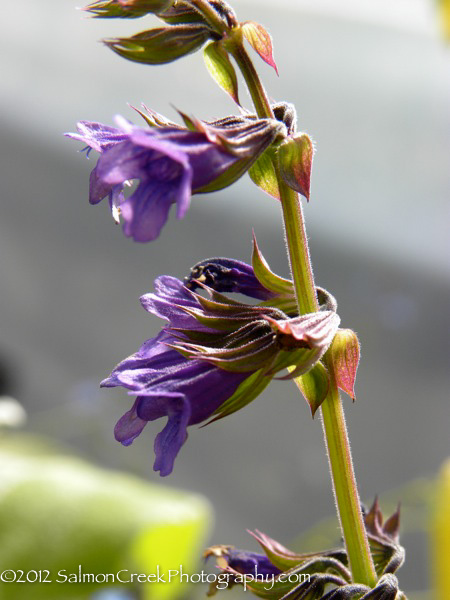
Hailing from the rocky crevices and grasslands of the Pyrenees and Alps in Western Europe, this alpine gem makes a winsome addition to any rock garden, stone wall or steps. Quilted leaves—deep green, scalloped and glossy—comprise a tidy semievergreen rosette that produces dainty upright spires of Penstemon-like violet-hued flowers.
Easily cultivated in a well-drained niche, either lean or rich, Dragon’s Mouth can be massed with other low growing perennials such as Marrubium incanum and Dracocephalum to create a tapestry-styled ground cover.
Blooms July – August.
Size: 8" – 12" high x 8" – 10" wide.
Hardy to zone 5.
Horminum pyrenaicum f. alboviolaceum (P-2235)
Each $11.00
Indigenous to the high meadows and lime-
enriched rocky slopes of the Pyrenees and European Alps, this neat, small-sized perennial sends forth numerous upright spires studded with endearing whorled creamy-white flowers donning violet lips and throats. The long-lasting tubular blooms, thought to resemble a dragon’s mouth, brighten the deep green evergreen rosette, which develops scalloped margins plus a textural, quilted evergreen aspect. Appreciative of superb drainage as well as protection from hot afternoon sun, hearty Dragon’s Mouth can be nudged into rockeries, troughs, alpine gardens or pathway edges, where it lures plant lovers and small nectar-sipping birds plus other pollinators.
Blooms June–August
Size: 8" – 10" high x 8" wide.
Hardy to zone 5.
Impatiens
From a genus comprised of hundreds of species, the following easily grown shade lovers offer both foliar and floral interest. Impatiens omeiana is surprisingly hardy, while the other selections are quite tender; all look compelling in either a pot or a garden bed.
Impatiens namchabarwensis (P-1807)
OUT OF PRODUCTION AT THIS TIME
Email me when this plant is available
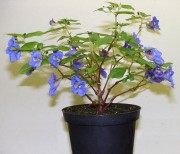
Hailing from the world’s deepest canyon in the remote Himalayan shadows of Mt. Namcha-Barwa, this wondrous 2003 discovery introduces perhaps the bluest flowering perennial Impatiens to date. Hallmarked by yellow-etched white throats and bright ultramarine or vivid blue-violet flared petals, whose colors vacillate with exposure, the extraordinary bountiful blooms appear nearly year round, conjuring images of exotic flying birds amid shiny serrated green leaves. Highly coveted, hard-to-find and perfect for containers, inside or out, Blue Diamond is a frost sensitive temptress that can be grown as a self-sowing annual in cold climates and as a perennial in milder areas, where it adores cool summers, even moisture and filtered light, and abhors hot sun and frosty nights.
Blooms April–October.
Size: 18" high x 18" wide.
Hardy to zone 10.
Each $11.25
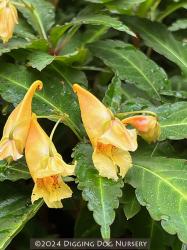
On Mount Emei’s misty slopes amid firs and tree rhododendrons, this attractive perennial Impatiens was collected at 8000 ft. by noted ecologist Dr. Don Jacobs.
The fantastic whorls of long slender, dark green leaves with silver veins and red undersides undoubtedly caught his eye during his 1983 expedition to China’s Sichuan Province. Cheered by showy yellow Snapdragon-like flowers in late summer, cold-tolerant Impatiens omeiana knits a nonfussy deciduous ground cover, naturalizing over time from wide-spreading underground stolons. Its colorful foliage brings textural appeal to a shady woodland setting and is ideal for a moderately moist, well-drained location.
Blooms September–October.
Size: 15" high x 2' 0" – 3' 0" wide.
Hardy to zone 7.
Impatiens sodenii ‘Flash’ (P-1523)
Each $11.25
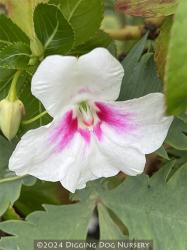
Impatiens aficionado, Derick Pitman developed this new, easygoing enchantress. Brushed with pink painterly strokes radiating from each center, shapely, 3 in. snow-white blooms are poised above polished green leaves. A perennial in warm climates, an annual in cold areas and a made-in-heaven match for a container, self-sowing ‘Flash’ can be shown off in bright shade where its multibranched, semisucculent stems are quick to fill out.
Blooms May – October.
Size: 4' 0" – 5' 0" high x 3' 0" wide.
Hardy to zone 10.
Inula
These upright, easygoing perennials promise to brighten any sunny spot with their cheerful display of yellow, daisy-like flowers. Inulas belong to the Asteraceae family and require little maintenance, asking only for well drained soil.
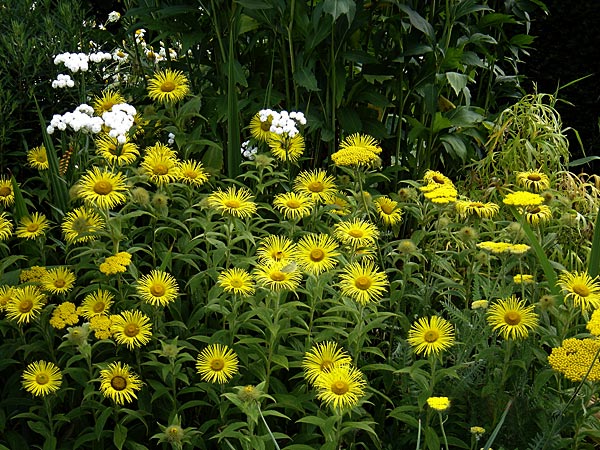
With finely petaled flowers so yellow and round that they look like the sun in a young child’s drawing, the vigorous Inula hookeri guarantees a vibrant effect. If given plenty of space plus moisture-retentive soil, trust its upright stems and bright green leaves to create a strong, dense clump. We’re especially fond of its fuzzy buds, and like to unite this vivacious perennial with Crocosmia ‘Lucifer’ and Thalictrum rochebrunianum.
Blooms late July–October.
Size: 4' 0" high x 18" & spreading wide.
Hardy to zone 5.
Each $11.00
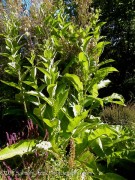

The species name of this perennial pretty much sums up its monumental presence. Tough, roughly textured, Dock-like leaves create a verdant mass, diminishing in size as they ascend stout stalks.
The towering purple-streaked stems are crowned with widely branching heads of 3 to 4 in. daisies, delicately rayed, golden yellow blooms that emerge from brown buds. Give it plenty of room, and highlight its massive stature with the arresting color and delicate foliage of Thalictrum ‘Elin’.
Blooms August–mid-September.
Size: 7' 0" – 8' 0" high x 4' 0" – 5' 0" wide.
Hardy to zone 6.
Inula racemosa ‘Sonnenspeer’ (P-1654)
Each $11.00
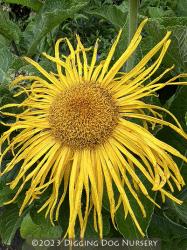
Soaring to lofty altitudes, this impressive perennial launches nearly 7 ft. tall, red-streaked stalks clothed in large, wavy hirsute leaves up to a foot long. Big, bright yellow daisies—narrow-rayed and shaggy looking—are borne among the verdant foliage on lengthy spires.
All these generous proportions forge a dramatic clumping specimen that can be underplanted with contrasting ground covers such as Sesleria ‘Greenlee’ or Pennisetum spathiolatum in the wild garden, back of the border or pond side. Even stately as it goes dormant, ‘Sonnenspeer’s glistening bronze leaves offer fall and early winter appeal.
Blooms June – September.
Size: 6' 0" – 7' 0" high x 3' 0" wide.
Hardy to zone 4.
Iris chrysographes ‘Black Form’ (P-2100)
Each $12.75
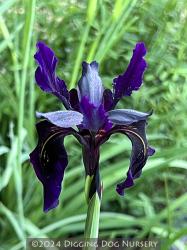
Possessing a posh mystique, the 3 in. wide perfumed blooms are suffused with smooth midnight-purple hues. Cut-flower-perfect flowers perch upon svelte 2 ft. tall stems supported by a green gathering of slender upright blades. Appreciative of rich, well-drained, moderately moist soil, this classy beardless Iris is a noncoddle small-sized perennial that can be easily tucked into a border and shown to stunning effect amid Salvia nemorosa ‘Amethyst’ and Euphorbia ‘Great Dixter’.
Blooms June–July
Size: 2' 0" high x 12" – 15" wide.
Hardy to zone 4.
Touted as the easiest to grow and hardiest of the native Iris, this versatile west coast denizen rallies copious good-sized blooms perched on slim wand-like stems and slender, low-growing grass-like greenery. Adored by bees, butterflies and gardeners, the showy flowers are commonly etched with dark violet veins and range in color from pastel lavender to vivid purple and soft blue-violet. Tenax is Latin for “tenacious” and refers to the strong fibrous foliage, whose brawn endures deer, rabbits and dry spells, and once provided a source for Native Americans’ ropes and cords. Tough-Leaf Iris’ natty low evergreen mound can be cozied amid rocks, along a pathway or a perennial border’s edge, where it begs good drainage, naps during the summer and handles various soil types.
Blooms April–mid-June
Size: 14" high x 12" – 2' 0" wide.
Zone 6b.
Iris versicolor ‘Purple Flame’ (P-2286)
Each $12.50
Though the species is native to the shorelines, wetlands and marshes of the eastern U.S., this distinctive 2020 introduction hails from Mt. Cuba. Enriched by lavish eggplant hues, the vertical blade-like clump eventually fades to green once the weather warms, and then unfurls abundant large, yellow-throated, rich purple flowers atop smooth dark stems, boasting both a visual feast plus a butterfly and hummingbird mecca. ‘Purple Flame’ looks spectacular en masse in borders, water gardens, boggy sites and pond sides, where its adaptable persona appreciates moist feet and braves bunnies as well as deer.
Blooms June
Size: 2' 0" – 2-1/2' high x 18" – 2' 0" wide.
Hardy to zone 3.








